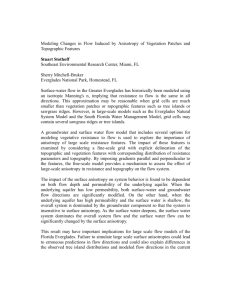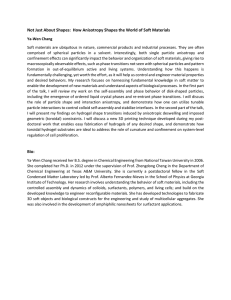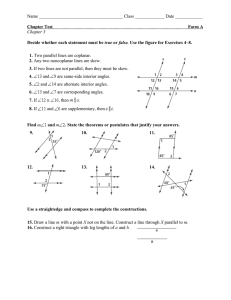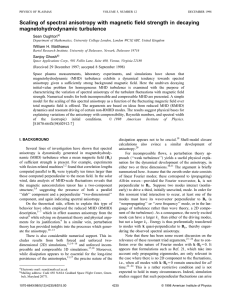Anisotropy of Solar Wind Turbulence in the Dissipation Range
advertisement
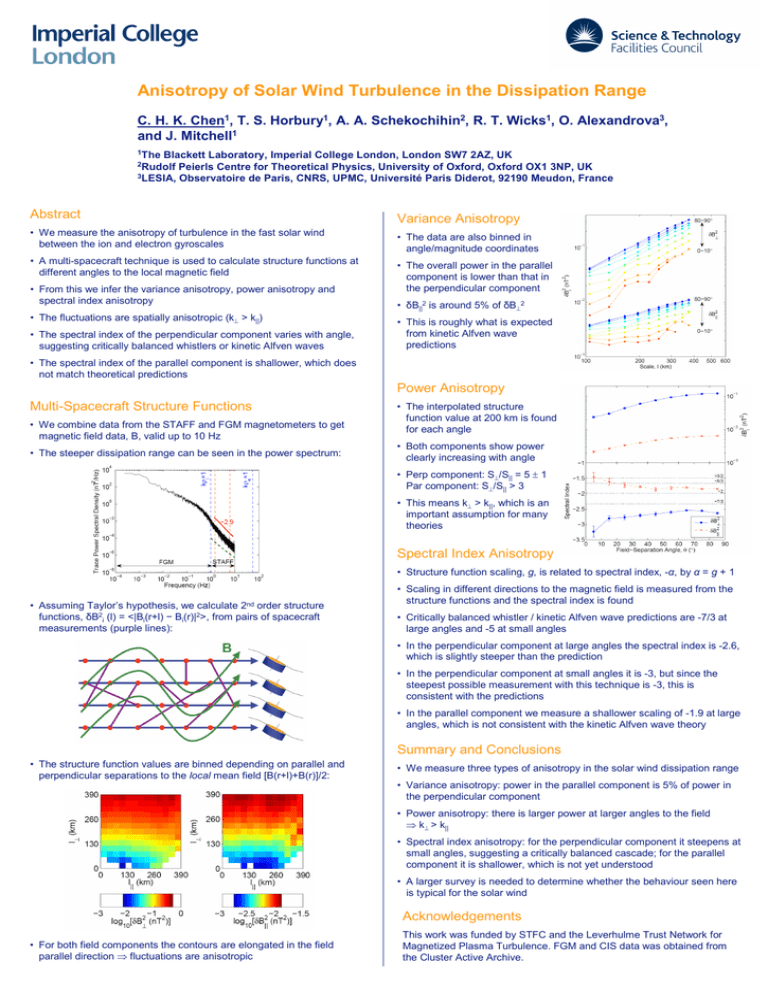
Anisotropy of Solar Wind Turbulence in the Dissipation Range C. H. K. Chen1, T. S. Horbury1, A. A. Schekochihin2, R. T. Wicks1, O. Alexandrova3, and J. Mitchell1 1The Blackett Laboratory, Imperial College London, London SW7 2AZ, UK Peierls Centre for Theoretical Physics, University of Oxford, Oxford OX1 3NP, UK 3LESIA, Observatoire de Paris, CNRS, UPMC, Université Paris Diderot, 92190 Meudon, France 2Rudolf Abstract Variance Anisotropy • We measure the anisotropy of turbulence in the fast solar wind between the ion and electron gyroscales • The data are also binned in angle/magnitude coordinates • A multi-spacecraft technique is used to calculate structure functions at different angles to the local magnetic field • The overall power in the parallel component is lower than that in the perpendicular component • From this we infer the variance anisotropy, power anisotropy and spectral index anisotropy • The fluctuations are spatially anisotropic (k⊥ > k||) • The spectral index of the perpendicular component varies with angle, suggesting critically balanced whistlers or kinetic Alfven waves • δB||2 is around 5% of δB⊥2 • This is roughly what is expected from kinetic Alfven wave predictions • The spectral index of the parallel component is shallower, which does not match theoretical predictions Power Anisotropy Multi-Spacecraft Structure Functions • We combine data from the STAFF and FGM magnetometers to get magnetic field data, B, valid up to 10 Hz • The steeper dissipation range can be seen in the power spectrum: • The interpolated structure function value at 200 km is found for each angle • Both components show power clearly increasing with angle • Perp component: S⊥/S|| = 5 ± 1 Par component: S⊥/S|| > 3 • This means k⊥ > k||, which is an important assumption for many theories Spectral Index Anisotropy • Structure function scaling, g, is related to spectral index, -α, by α = g + 1 • Assuming Taylor’s hypothesis, we calculate 2nd order structure functions, δB2i (l) = <|Bi(r+l) − Bi(r)|2>, from pairs of spacecraft measurements (purple lines): • Scaling in different directions to the magnetic field is measured from the structure functions and the spectral index is found • Critically balanced whistler / kinetic Alfven wave predictions are -7/3 at large angles and -5 at small angles • In the perpendicular component at large angles the spectral index is -2.6, which is slightly steeper than the prediction • In the perpendicular component at small angles it is -3, but since the steepest possible measurement with this technique is -3, this is consistent with the predictions • In the parallel component we measure a shallower scaling of -1.9 at large angles, which is not consistent with the kinetic Alfven wave theory Summary and Conclusions • The structure function values are binned depending on parallel and perpendicular separations to the local mean field [B(r+l)+B(r)]/2: • We measure three types of anisotropy in the solar wind dissipation range • Variance anisotropy: power in the parallel component is 5% of power in the perpendicular component • Power anisotropy: there is larger power at larger angles to the field ⇒ k⊥ > k|| • Spectral index anisotropy: for the perpendicular component it steepens at small angles, suggesting a critically balanced cascade; for the parallel component it is shallower, which is not yet understood • A larger survey is needed to determine whether the behaviour seen here is typical for the solar wind Acknowledgements • For both field components the contours are elongated in the field parallel direction ⇒ fluctuations are anisotropic This work was funded by STFC and the Leverhulme Trust Network for Magnetized Plasma Turbulence. FGM and CIS data was obtained from the Cluster Active Archive.

